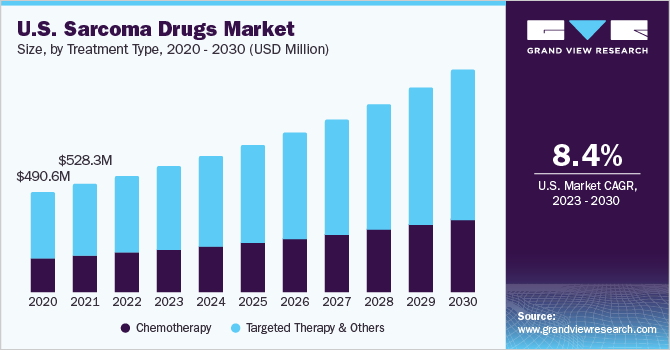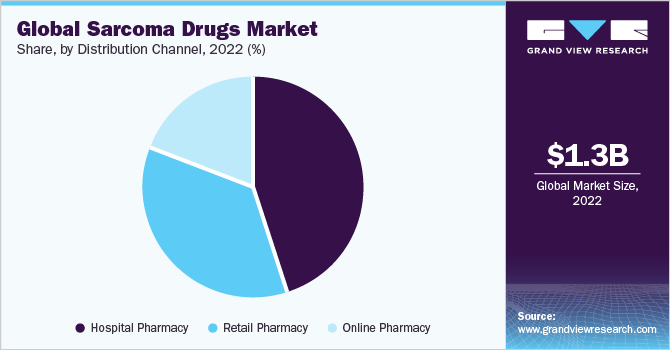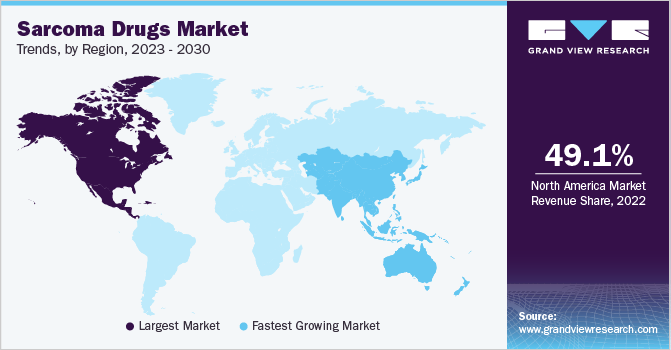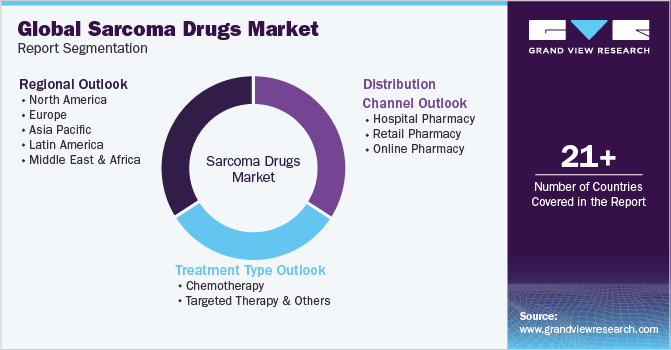- Home
- »
- Pharmaceuticals
- »
-
Sarcoma Drugs Market Size, Share & Growth Report, 2030GVR Report cover
![Sarcoma Drugs Market Size, Share & Trends Report]()
Sarcoma Drugs Market Size, Share & Trends Analysis Report By Treatment Type (Chemotherapy, Targeted Therapy), By Distribution Channel (Hospital Pharmacy, Retail Pharmacy, Online Pharmacy), By Region, And Segment Forecasts, 2023 - 2030
- Report ID: GVR-2-68038-528-1
- Number of Report Pages: 93
- Format: PDF, Horizon Databook
- Historical Range: 2018 - 2021
- Forecast Period: 2023 - 2030
- Industry: Healthcare
Report Overview
The global sarcoma drugs market size was valued at USD 1,287 million in 2022 and is expected to grow at a compound annual growth rate (CAGR) of 8.9% from 2023 to 2030. Soaring adoption of novel drugs, the presence of a strong developmental pipeline, the rising incidence of soft tissue sarcomas (STS), and increasing R&D activities are some of the key trends stoking the market growth. According to the Sarcoma Foundation of America (SFA), approximately 17,000 people were diagnosed with sarcoma in 2022 in the U.S., and around 7,230 deaths were caused due to it. Furthermore, the global rise in the prevalence of soft tissue sarcoma and the rise in awareness among people are propelling the market growth.

Increased sarcoma cases have been attributed to more awareness, an aging population, and better diagnostic methods. The expanding patient population drives the need for effective medications and treatments, which is driving the price of sarcoma medications.
The market for sarcoma drugs is expanding due to advances in research and development. Innovative sarcoma medication development is receiving significant funding from pharmaceutical firms and academic organizations. The main goals are to investigate novel therapeutic modalities and enhance the efficacy and security of current medicines.
The development of immunotherapies, targeted medicines, and combination treatments offers promise for better patient outcomes, which fuels the need for sarcoma medications. The process of finding new drugs and developing them is accelerated by partnerships and collaborations among industry participants, which also helps the market to expand.
Sarcoma is a rare cancer that appears in the body's connective tissues, including the bones, muscles, tendons, blood vessels, and fat. Sarcoma can affect people of various ages, although the precise reasons are still unclear. There are several subtypes of sarcoma, each with unique traits and possible risk factors. Sarcoma tumors can affect any body part, including nerves, tendons, bones, muscles, fat, and skin. Though sarcomas represent a heterogeneous group of over 50 different histological subtypes, Soft Tissue Sarcoma (STS) accounts for approximately 87.0% of all sarcoma cases.
In contrast, malignant bone sarcomas represent nearly 13% of all cases. Globally, the annual incidence rate of STS is 2-3 per 100,000 people. Risk factors include genetic mutation such as inherited defects in the APC gene, TP53 gene, and RB1 gene, damaged lymph system, chemical exposure, and radiation. The lifetime risk of developing sarcoma is 0.4%. Approximately 45% of bone sarcomas and 21.0% of STS are diagnosed in people aged 0-35 years.
Currently, chemotherapy and targeted therapy are the only approved treatments for sarcoma. Several immuno-oncology agents are also under investigation. Recent approvals of chemotherapy drugs such as Eisai’s Halaven and Johnson & Johnson’s Yondelis are based on superior efficacy compared to previously available anthracycline-based treatment regimens.
The COVID-19 pandemic had a positive impact on the sarcoma drugs market. Increased research and development efforts have been motivated by the need to identify treatments for COVID-19, which has also helped create novel sarcoma medicines. Drug approvals for sarcoma have occurred more quickly due to the accelerated regulatory procedures created for COVID-19 therapies. Patients with sarcoma have benefited from telemedicine and remote care during the pandemic since it has improved patient monitoring and increased access to specialists. Additionally, the collaborative atmosphere and data sharing driven by the pandemic may help develop novel sarcoma medications. Additionally, greater public awareness and financing for healthcare research have also acted as key factors for market growth.
Treatment Type Insights
Based on the treatment types, the market is segmented into chemotherapy, targeted therapy & others. The targeted therapy and others segment dominated the market with a market share in 2022, and it is expected to maintain its dominance in the market throughout the forecast period. Targeted therapy is emerging as a highly successful technique in the treatment of sarcoma. Compared to standard chemotherapy, these medicines offer more accuracy, fewer side effects, and higher response rates by selectively targeting the molecular defects and pathways implicated in sarcoma formation. They may be adjusted to a patient's tumor's unique features, allowing personalized treatment methods. Furthermore, targeted therapy can be used with other techniques to overcome resistance. As research advances, targeted treatment is likely to have an important role in improving outcomes for sarcoma patients.
The Sarcoma treatment landscape has changed dramatically in the last few years with the introduction of targeted therapies. As one of the first molecularly targeted drugs approved for Chemotherapy tumors, Gleevec’s approval as the first-line therapy for GIST, a major sarcoma sub-type, changed the treatment paradigm for GIST. Following Gleevec, other tyrosine kinase inhibitors (TKIs) have been approved for GISTs, such as Sutent and Stivarga, and Votrient for non-GIST soft tissue sarcomas. In addition to TKIs, Lartruvo, the monoclonal antibody that targets platelet-derived growth factor receptor (PDGFR), was shown to extend the overall survival of STS patients and was approved in 2016 in the U.S. as a breakthrough therapy. New drugs are limited to Xgeva, a receptor activator of nuclear factor B ligand (RANKL) inhibitor for bone sarcomas.
Current research in sarcoma uses novel treatments such as targeted therapy, immunotherapy, and combination regimens. Bristol-Myers Squibb’s Opdivo + Yervoy combination is being investigated in a Phase II trial for patients with previously treated metastatic sarcoma. The development of immuno-oncology agents for sarcoma treatment is estimated to target major unmet needs, including disease recurrence, improving progression-free survival, overcoming tumor resistance, and maintaining quality of life.
Pipeline Insights
The role of checkpoint inhibitors (PD-1/PD-L1) in STS is under evaluation in multiple Phase I/II trials. In conjunction with standard therapies, these treatments are poised to provide patients with safer and more effective treatment options. Merck is investigating its PD-1 inhibitor Keytruda as monotherapy and in combination with Incyte’s IDO1 inhibitor epacadostat in patients with advanced STS and bone sarcomas.
Out of 45 drugs in the clinical pipeline, 12 molecular targeted drugs are in development for the treatment of STS and bone sarcoma. Cancer vaccines and gene therapy are also generating interest as potential treatments for STS. Several other small molecules and monoclonal antibodies are in active development in Phase I and II trials.
Distribution Channel Insights
Based on the distribution channel, the market is segmented into hospital pharmacy, retail pharmacy, and online pharmacy. The hospital pharmacy segment dominated the market with a market share of around 45% in 2022. Hospital pharmacies are critical for the delivery of sarcoma medicines. They obtain and stock a large selection of these specialized pharmaceuticals, ensuring that healthcare practitioners have access to them. Pharmacists ensure medicine safety and quality control by adhering to storage requirements and performing routine inspections. They work with healthcare experts to provide knowledge on medication interactions, doses, and adverse effects. Hospital pharmacies offer specialized compounding services for customized drugs. They deliver sarcoma medications to patients, verifying the accuracy and offering counseling.

The online pharmacy segment is estimated to be the fastest-growing segment during the forecast period, with a CAGR of 10.4%. Online pharmacies are essential in the sarcoma medications industry as they provide patients with accessibility and convenience, particularly those in distant places. They provide a broader selection of pharmaceuticals, including uncommon or specialized sarcoma treatments. Patients may afford these drugs because of competitive pricing. Sarcoma sufferers can also benefit from online pharmacies in terms of information, assistance, and privacy. They fill the void by providing international access to pharmaceuticals that are only sometimes available locally.
Regional Insights
North America dominated the market and accounted for the largest revenue share of 49.1% in 2022, owing to its rich healthcare infrastructure, superior medical research skills, and big patient population. The region's robust regulatory frameworks and reimbursement policies facilitate drug approval and access. North America is home to significant pharmaceutical corporations and research facilities which promote the discovery and marketing of novel medications. The region's high healthcare spending and insurance coverage contribute to the cost of sarcoma medications. Furthermore, strong patient advocacy groups and awareness campaigns in North America concentrate attention and funding on sarcoma research and treatment.

Asia Pacific is expected to grow at the fastest CAGR of 9.6% during the forecast period. Due to various causes, the Asia Pacific market is emerging as the fastest-expanding market for sarcoma medications. The region's vast and constantly rising population and improved healthcare infrastructure result in greater diagnosis rates and an increased need for effective sarcoma therapies. Advances in medical research and development, favorable government efforts, and cooperation between global and local pharmaceutical businesses have all contributed to the availability and accessibility of sarcoma medications. Additionally, rising healthcare spending, rising disposable income, and increased knowledge of cancer treatment alternatives support the expansion of the Asia Pacific sarcoma medicines market.
Key Companies & Market Share Insights
Pharmaceutical companies competing in the sarcoma medicine market use various techniques to achieve a competitive edge. These include intensive research and development efforts to uncover novel therapeutic targets and mechanisms of action and personalized medicine techniques that focus on specific sarcoma subtypes or biomarkers. Strategic alliances and partnerships with academic institutions and other pharmaceutical businesses assist in utilizing knowledge and resources. Companies also spend on clinical trials, post-approval research, and label extensions to develop rigorous effectiveness and safety data and to investigate additional applications. Strong ties with key opinion leaders and healthcare providers and creative pricing and reimbursement methods enable market access and uptake. Manufacturing excellence, supply chain optimization, and patient-centric solutions strengthen their competitive position.
For instance, In May 2023, Bayer announced that Larotrectinib sulfate is under phase II clinical trials. This drug is formulated for treatment of both adults and children having sarcoma with solid tumors.
In March 2022, a biotechnology firm named Phio Pharmaceuticals Corp., which produces immuno-oncology drugs based on its self-delivering RNAi therapeutic platform announced its partnership with AgonOx, Inc. for developing cancer drugs based on T-cells by combining tumor-infiltrating technology of AgonOx with RNAi of Phio. Following are some of the major players in the global sarcoma drugs market:
-
Pfizer Inc.
-
Novartis AG
-
Eli Lilly and Company
-
Bayer AG
-
Eisai Co., Ltd
-
Johnson & Johnson
-
Merck & Co., Inc.
-
Daiichi Sankyo Company, Limited
Sarcoma Drugs Market Report Scope
Report Attribute
Details
Market size value in 2023
USD 1,396.6 million
Revenue forecast in 2030
USD 2534.5 million
Growth Rate
CAGR of 8.9% from 2023 to 2030
Base year for estimation
2022
Historical data
2018 - 2021
Forecast period
2023 - 2030
Report updated
September 2023
Quantitative units
Revenue in USD million and CAGR from 2023 to 2030
Report coverage
Revenue forecast, company ranking, competitive landscape, growth factors, and trends
Segments covered
Treatment type, distribution channel, region
Regional scope
North America; Europe; Asia Pacific; Latin America; and MEA
Country scope
U.S.; Canada; UK; Germany; France; Italy; Spain; Denmark; Sweden; Norway; China; Japan; India; Australia; South Korea; Thailand; Brazil; Mexico; Argentina; Saudi Arabia; South Africa; UAE; Kuwait
Key companies profiled
Pfizer Inc.; Novartis AG; Eli Lilly and Company; Bayer AG; Eisai Co., Ltd; Johnson & Johnson; Merck & Co., Inc; Daiichi Sankyo Company, Limited
Customization scope
Free report customization (equivalent up to 8 analyst’s working days) with purchase. Addition or alteration to country, regional & segment scope
Pricing and purchase options
Avail customized purchase options to meet your exact research needs. Explore purchase options
Global Sarcoma Drugs Market Report Segmentation
This report forecasts revenue growth at global, regional, and country levels and provides an analysis of the latest industry trends in each of the sub-segments from 2018 to 2030. For this study, Grand View Research has segmented the global sarcoma drugs market based on treatment type, distribution channel, and region:

-
Treatment Type Outlook (Revenue in USD Million, 2018 - 2030)
-
Chemotherapy
-
Targeted Therapy & Others
-
-
Distribution Channel Outlook (Revenue in USD Million, 2018 - 2030)
-
Hospital pharmacy
-
Retail pharmacy
-
Online Pharmacy
-
-
Regional Outlook (Revenue in USD Million, 2018 - 2030)
-
North America
-
U.S.
-
Canada
-
-
Europe
-
UK
-
Germany
-
France
-
Italy
-
Spain
-
Sweden
-
Norway
-
Denmark
-
-
Asia Pacific
-
China
-
Japan
-
India
-
Australia
-
Thailand
-
South Korea
-
-
Latin America
-
Brazil
-
Mexico
-
Argentina
-
-
Middle East and Africa
-
Saudi Arabia
-
South Africa
-
UAE
-
Kuwait
-
-
Frequently Asked Questions About This Report
b. The global sarcoma drugs market size was estimated at USD 1,287 million in 2022 and is expected to reach USD 1,396.6 million in 2023.
b. The global sarcoma drugs market is expected to witness a compound annual growth rate of 8.9% from 2023 to 2030 to reach USD 2534.5 million by 2030.
b. The U.S. dominated the sarcoma drugs market with a share of 44.2% in 2022. This is attributable to multiple product launches coupled with increased adoption of novel therapeutics, and the presence of key manufacturers.
b. Some key players operating in the sarcoma drugs market include Novartis, Eli Lilly, Amgen, Pfizer, Johnson & Johnson, Eisai, and Bayer.
b. Soaring adoption of novel drugs, the presence of strong developmental pipeline, rising incidence of soft tissue sarcomas (STS), and increasing R&D activities are expected to boost the adoption of telemedicine over the forecast period.
Share this report with your colleague or friend.
![gvr icn]()
NEED A CUSTOM REPORT?
We can customize every report - free of charge - including purchasing stand-alone sections or country-level reports, as well as offer affordable discounts for start-ups & universities. Contact us now
![Certified Icon]()
We are GDPR and CCPA compliant! Your transaction & personal information is safe and secure. For more details, please read our privacy policy.
We are committed towards customer satisfaction, and quality service.
"The quality of research they have done for us has been excellent."





